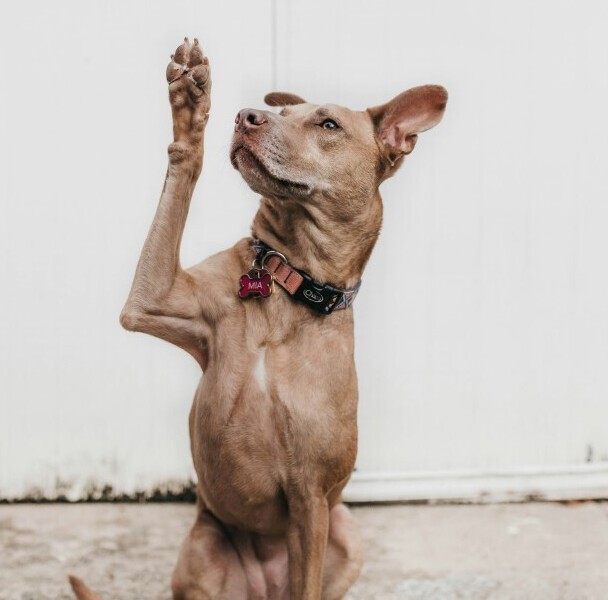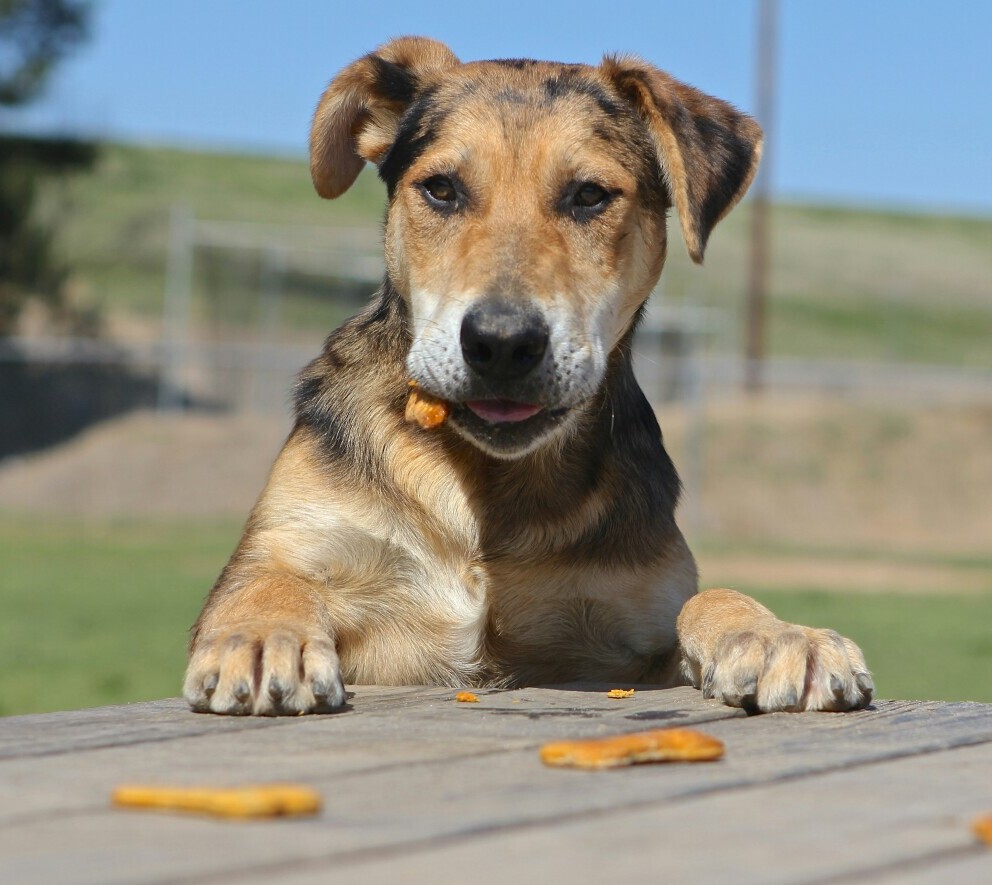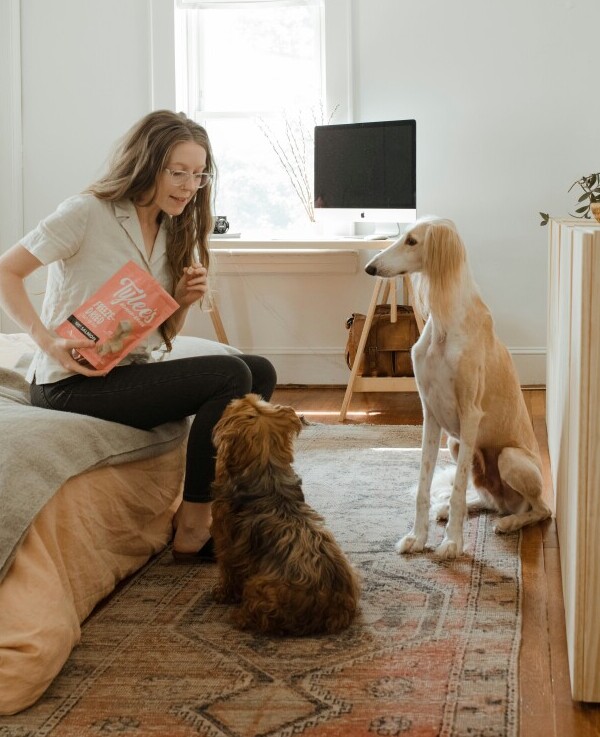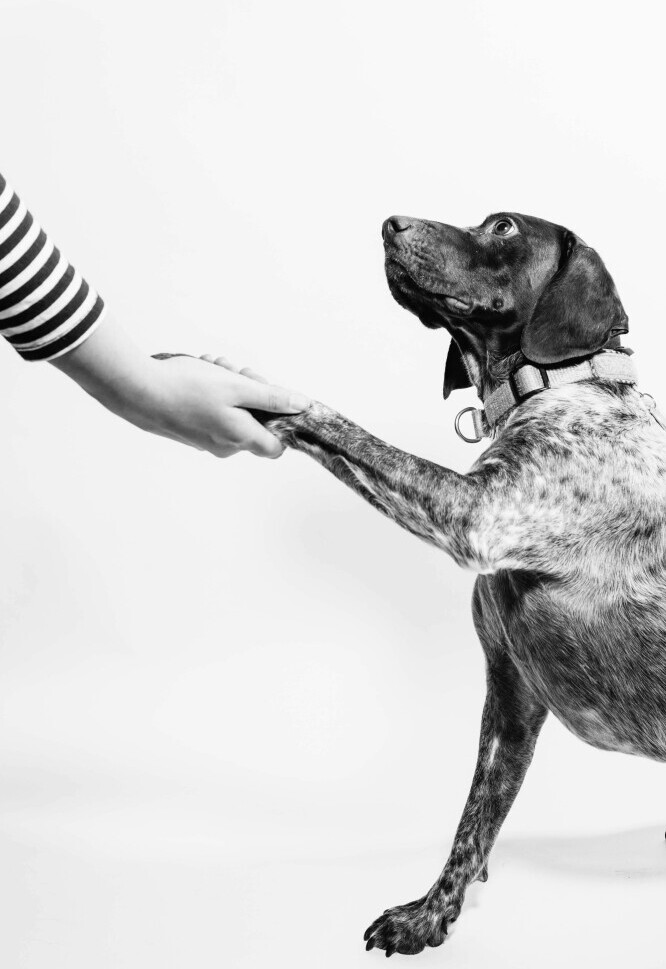
A few of the links in this post are affiliate links. If you buy something, we may earn a small commission (no extra bones from your wallet 🐾). Thanks for helping support the site and all of the dog adventures!
Dogs are cute, cuddly, and sometimes a bit pesky when it comes to mealtime. The big brown eyes staring up at you can be hard to resist. But have you ever wondered why your furry friend is so interested in sharing your dinner? It often boils down to natural instincts and learned behavior. Today we’re talking about a dog’s table begging and what you can do about it.
Dogs, being social animals, naturally look to their human family for guidance. They’ve got a keen sense of smell and a taste for what you’re cooking, which can make them hard to ignore when they’re practically drooling by your chair. Anything they can smell in your kitchen is going to pique their curiosity.
Some dogs beg because they’re simply after a bit of attention. If your dog is anything like mine, they might just be looking to score some extra belly rubs. Sometimes, though, it’s not just about the scrumptious aroma wafting from your plate—it’s about getting a little extra love and acknowledgment.
Other times, it might be a nutritional need they feel isn’t being met. If their regular meals aren’t satisfying them, they could be reaching out for more in the form of your tasty leftovers. So ask yourself if the food you have been giving them has been enough to satisfy their appetite.
Figuring out the triggers for this behavior is key to managing it. Is it the scent of roast chicken being carved that triggers your dog, or is it more about when everyone’s gathered around the table? Every dog is different, but use context to help you understand what the underlying cause may be.
Observing these little details will help you understand what pulls your dog to the table like a magnet. Once you pinpoint why and when your dog starts begging, you’ll have a better shot at steering away from those pleading looks.
Begging often stems from learned behaviors or lack of boundaries. Explore solutions in Common Dog Behavior Problems and How to Fix Them.

The Importance of Consistency
Handling a dog’s table manners is much like dealing with kids—consistency is the golden rule. Dogs thrive on routine, and setting household rules will help them know what to expect. That means making sure table scraps are off-limits to everyone, not just when it’s inconvenient for you. If you let them eat scraps and then yell at them the next day for being by the table, you’re going to send mixed signals and your dog will never understand.
One common misstep pet owners make is giving in from time to time. You know the drill: “Just this once” can turn into a bad habit. If you cave in even once, your dog learns persistence pays off. It’s like a jackpot payoff that makes them try harder next time. So if you really don’t want your dog sharing, make sure that you let them know that the dinner table is off limits.
Getting the whole family on board is essential. Everyone in the house should be on the same page about what behaviors are and aren’t allowed. If you’re firm about no treats from the table but others aren’t, it’s also going to send mixed messages, leaving your dog confused about what’s okay.
Sticking to these guidelines shows your dog there’s a standard of behavior expected during mealtimes. It’s about consistency day in, day out, that teaches your pup those table-surfing days are over. Changing behavior isn’t just about teaching your dog new tricks; it’s about showing them what gets rewarded and what doesn’t.
Using treats correctly reinforces desired behavior and discourages begging. Get practical tips in How to Use Treats for Dog Training.

Training Techniques to Curb Begging
Let’s chat about some practical strategies that can help train your dog to keep those paws off the dinner table. Teaching basic commands like ‘sit’ and ‘stay’ is an effective starting point. Get them to stay in a position that is comfortable for everyone when it’s time to sit at the table for dinner.
These commands are more than tricks—they’re tools to manage your dog’s behavior at mealtimes. Consistent practice of these commands can gradually reinforce what you expect when food is on the table. And it will keep your dog at bay if that’s your ultimate goal.
Consider employing positive reinforcement instead of punishment. Treats or affection given when your dog obeys the command to stay away from the table can work wonders. This type of encouragement helps your dog associate good behavior with rewards, paving the way for more peaceful meals.
Creating a separate feeding space for your dog also works wonders. Think of this as giving your dog their special zone where they can enjoy mealtime without distractions. By feeding your dog in a dedicated spot, away from the bustling kitchen or dining room, you’re training them to expect food in a specific area—one that doesn’t involve begging under the table.

Practical Solutions and Tools
Sometimes you need a little extra help to keep your dog out of trouble when you’re enjoying a meal. Using tools like pet gates or playpens can provide a physical boundary. It’s like setting up an invisible line your pup knows not to cross when dinner’s on the table. This helps manage their curiosity without needing you to constantly tell them off.
Establishing strict meal schedules can also benefit both you and your pet. When your dog knows exactly when to expect their meals, they’re less likely to do anything drastic to try and grab a snack in between. A full belly might just keep them too content to care about what’s on your plate.
Another neat trick is to leverage puzzle feeders or interactive toys. These can keep your dog occupied and mentally stimulated while you’re eating. With a little creativity, your pet’s longing gaze can turn into focused play with their new favorite toy. While they’re busy solving their puzzle toy for treats or kibble, you get to enjoy a peaceful meal.
Using such tools ensures that your dog remains not only physically occupied but mentally engaged. It’s all about making sure that mealtime is enjoyable for everyone involved. And it will help them understand the difference between their dinnertime and your dinnertime.
If you have multiple dogs, managing begging behavior can be tricky. Learn strategies in Balancing Multi-Dog Households.

Engaging Your Dog Positively
Keeping your dog entertained beyond mealtime is crucial, and promoting positive behavior through enriching activities can make a huge impact. A bored dog is more likely to beg, so incorporating fun activities like fetch or tug-of-war into your daily routine can keep them satisfied and less likely to drool over your dinner.
Physical exercise plays a massive role in managing your dog’s behavior. Regular walks or runs exhausting that pent-up energy can make your dog a calmer and happier companion. A well-exercised dog is typically more content, which translates to better behavior at the table.
There might be times when, despite your best efforts, your dog continues to beg. If that happens, seeking professional help can be a game-changer. Consulting a dog trainer or behaviorist can give you a tailored approach to handle specific issues. They bring in fresh eyes and expertise that can make a big difference in steering your dog away from those table cravings.
Use some of these strategies to keep your dog from being a bother at dinnertime. Everyone should feel comfortable at the table, so if that means the dog stays away, then enforce the rules consistently so it becomes normal for your dog to keep away from the table. And everyone can enjoy their own dinner in peace, including your dog!
